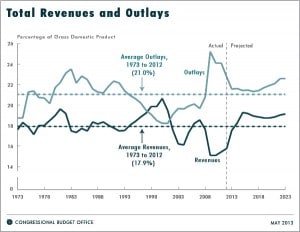The deficit drops. Now can Washington help create jobs?
2009: $1,400 billion
2013: $642 billion
To distinguish between real and imagined threats, that’s the first purpose of this Climate-Proof blog. And the federal budget deficit is beginning to look like an imagined threat.
 The Congressional Budget Office (Congress’ own analysts, not the White House or a liberal think tank) has a new prediction of this year’s deficit. Turns out it’s not much different from deficit levels for the past 30 years we thought were sustainable.
The Congressional Budget Office (Congress’ own analysts, not the White House or a liberal think tank) has a new prediction of this year’s deficit. Turns out it’s not much different from deficit levels for the past 30 years we thought were sustainable.
Thanks to revenues from our stronger economy, and expense cuts like the Sequester, projections of the 2013 deficit keep dropping. CBO just lowered theirs from $845 billion to $642 billion. That’s half the deficit we ran in 2009.
Yes, Social Security and Medicare are still likely to push the shortfall back to worrisome levels over the coming decades. But today in Washington there’s reduced pressure for near-term expense cuts or tax increases. Plus a few extra months before we hit the debt ceiling, when Congress can hold the country hostage again.
So, unlike groundwater and retirement savings, both of which are drying up, here’s one trend we’ve been tracking that’s beginning to look less threatening to American families. Maybe it’s a good time for us to tell our men and women in Congress how to use this reduced deficit concern. I have two suggestions:
1. Use the funds to create some serious job programs. After all, you and I and everyone else in the bottom 90% of Americans still haven’t seen any improvement in our post-recession earnings yet. And don’t lower taxes on the rich for this purpose; the CBO (and Savvy Families) argue that’s the least effective job-creation method of all.
2. Use the time to create some long-term changes to entitlement programs? After all, the CBO says we have a respite only; the deficit will someday be a threat again.



